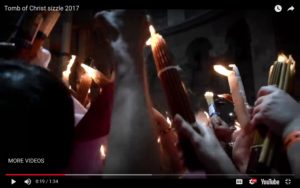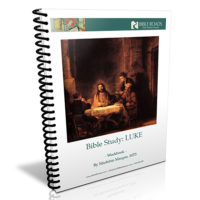Visiting Jerusalem as a Christian pilgrim and searching for the site where Jesus was buried and arose can be a conundrum. Why? Because tour guides take you to two sites, not one!
First is The Church of the Holy Sepulcher and the second is known simply as ‘The Garden Tomb’. Both are beautiful and moving in their own way yet Christians for centuries have tried to determine which is the authentic Jesus burial and resurrection site.
To solve the mystery, it’s helpful to get grounded in the Gospel story and the facts it relays:
- That Golgotha, Hebrew for ‘the place of the skull’ (Luke 23:33) was the site of the crucifixion and near the city (John 19:20). This means it was not IN the city walls.
- Three of the gospels agree that Joseph of Arimathea’s tomb was the site of Jesus’ burial and that the tomb was carved from rock. See Matt. 27:57, Luke 23:50-51; and John 19:38.
- John’s gospel explains the tomb was new and describes its location in relation to the crucifixion: “The place of crucifixion was near a garden, where there was a new tomb, never used before” (John 19:41).
- All four gospels concur that a large round stone was rolled to block the entrance to the tomb and seal it. See Matt. 27:60, Mark 15:46, Luke 24:2, and John 20:1.
- A verse in the book of Hebrews reiterates that Golgotha was outside the city walls: Therefore Jesus also suffered outside the city gate in order to sanctify the people by his own blood ( 13:12, NRSV, emphasis added).
During Constantine’s reign (306-337), the Emperor’s mother, Helena, traveled to ancient Palestine to locate sacred sites of Christendom. After all, her son was the newly proclaimed Holy Roman Emperor. The 4th century tradition claims that she located the site of Jesus’ tomb with the help of locals whose families had always lived in that area. The result? The first building of today’s Church of the Holy Sepulchre.
The problem scholars began to identify in the 19th century, however, was that the Biblical accounts told the story in such a way that both Golgotha and Jesus’ tomb had to be located outside the walls of 1st century Jerusalem. The problem was that The Church of the Holy Sepulchre had been found to be inside city walls archaeologists found in the 19th century. Was one of the most holy sites of all of Christendom a topographical and historical error?
The May/June 2016 issue of Biblical Archaeology Review has shed new light on the controversy, and very convincing light to many. Two scholars* report that the wall discovered in 1893, believed to be the ancient city wall of Jerusalem in Jesus’ time, was is in fact too small for a city wall and also not built until the 4th century A.D. This meant that The Church of the Holy Sepulchre could indeed have been located outside the city walls, since both Roman and Jewish custom conducted crucifixion and burial outside such walls.
In addition, archaeological work in the 1970’s revealed that underneath The Holy Sepulchre Church was a rock quarry that had been in use since before the 1st century BC. This fit the Biblical description of Joseph of Arimathea’s tomb carved from rock. Such a quarry would have been located outside the city walls.
Also discovered were traces of gardens dating to the first century A.D., supporting Mark 15:21, Luke23:26 and John 19:41 that indicate the place of Jesus’ crucifixion was surrounded by gardens and fields.
There are other hints, but suffice it to say that all this work has done much to convince rigorous investigators that today’s Church of the Holy Sepulcher appears to be the location of Golgotha and the Master’s tomb.
Why tourists appreciate seeing both The Church of the Holy Sepulchre and The Garden Tomb is their vast difference. For all the ritual, tradition and ceremony of The Church of the Holy Sepulchre, The Garden Tomb is quiet, modest and seems unchanged in two thousand years. One can go inside to see the rock-ribbed walls surrounding a single slab of stone where a body would have been laid. It feels sacred and holy yet as their website explains, ‘where Jesus died is of little importance compared with why”.
As archaeology continues to find reason to believe The Church of the Holy Sepulchre might indeed be the authentic site of Jesus burial and resurrection and therefore the crucifixion and resurrection, organizations like The National Geographic are taking notice.
The National Geographic Society has recently opened an exhibit on the tomb that you can explore here for a virtual tour. Fascinating!





This is most interesting. Joseph of Arimathea probably would have had a very quiet and remote burial for the body of Jesus. It’s helpful to realize that the garden tomb represents those surrounding, as certainly the crowds filing through the Church of the Holy Seplecre with all its walls and high ceilings, traditions and rituals and ceremonies, does not.
Maddie, Thanks for this most recent blog/visuals. It’s been a very long time since I was in Jerusalem. I did visit the CofHS but not the garden tomb. My memory of the church is that it felt very busy and carved up with lots and lots of statues and other things to worship. And, I had this overwhelming sense of “I’m just not sure this is what he wanted us to do in following him.” But, I was very young at the time and didn’t have an appreciation for Christianity in its broadest and most diverse sense. I think today… Read more »
Thank you. I love getting your blogs. jane
I believe it is actually at the Basilica of Saint Stephen outside the Lions Gate in the Kidron valley. This is a debated burial site of St Stephen. It all adds up that it would be both for Stephen and Jesus. We know that Joseph of Aramethia owned this land. It fits all of the gospel descriptions and makes the most sense. Of course, religious officials would take Stephen out to this same place where his rabbi had been buried. Secondly, this is on the side of the old city where Mary’s family lived. Crucifying Christ just outside of where… Read more »